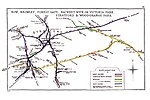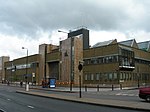Bow railway station

Bow was a railway station in Bow, east London, that was opened in 1850 by the East & West India Docks and Birmingham Junction Railway, which was later renamed the North London Railway (NLR). The station was situated between Old Ford and South Bromley, and was located on the north side of Bow Road, close to the second Bow Road station which was open from 1892 to 1949. A covered footway connected the two stations between 1892 and 1917. The original Bow station was replaced by a much grander station in 1870, designed by Edwin Henry Horne, which incorporated a concert hall that was 100 feet (30 m) long and 40 feet (12 m) wide. Bow was served not only by the NLR but also by Great Eastern Railway (GER) trains to Fenchurch Street and a shuttle service to Plaistow. The NLR line was severely damaged in the Blitz of World War II and the line east of Dalston Junction was closed in 1944 and never re-opened to passengers. The station buildings remained in use as a parcel office until it was closed in 1965. After being left derelict, Bow station was ultimately demolished during the construction of the Docklands Light Railway (DLR) which reused the old NLR line. Today, the station site is occupied by a car hire firm, and directly opposite lies Bow Church DLR station.
Excerpt from the Wikipedia article Bow railway station (License: CC BY-SA 3.0, Authors, Images).Bow railway station
Denmark Place, London Bow
Geographical coordinates (GPS) Address Nearby Places Show on map
Geographical coordinates (GPS)
| Latitude | Longitude |
|---|---|
| N 51.52833 ° | E -0.02211 ° |
Address
Denmark Place
E3 2GJ London, Bow
England, United Kingdom
Open on Google Maps








